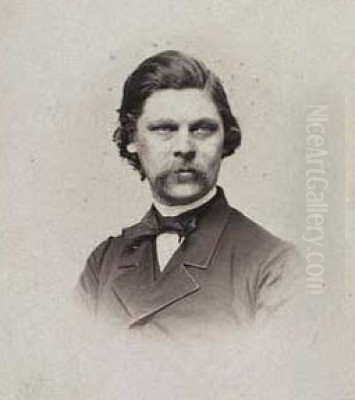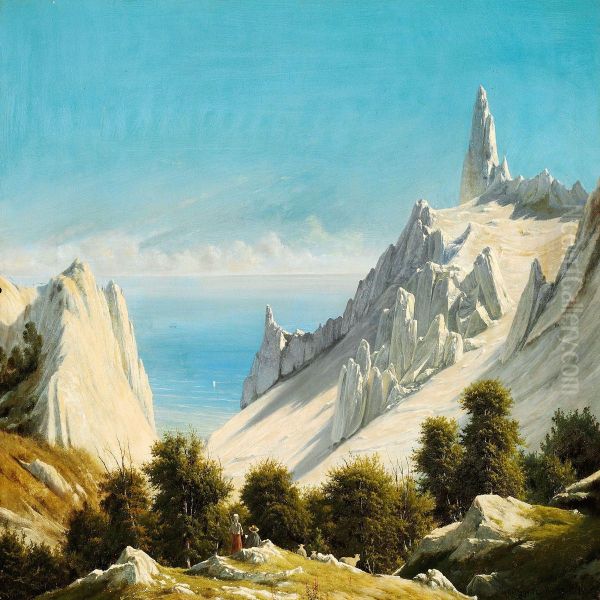
Georg Emil Libert stands as a significant figure in the rich tapestry of 19th-century Danish art. Born in Copenhagen in 1820 and living a long life until 1908, Libert dedicated his artistic career primarily to landscape painting, carving a unique niche for himself through his evocative depictions of nature, particularly scenes bathed in the ethereal glow of moonlight. His work bridges the later years of the Danish Golden Age with the enduring spirit of Romanticism, capturing the beauty and atmosphere of Denmark and its Nordic neighbours.
Early Life and Academic Foundations
Georg Emil Libert's artistic journey began in the vibrant cultural milieu of Copenhagen. He pursued formal training at the prestigious Royal Danish Academy of Fine Arts (Det Kongelige Danske Kunstakademi). This institution was the crucible of the Danish Golden Age, a period roughly spanning the first half of the 19th century, where Danish art, architecture, and culture flourished, establishing a distinct national identity.
At the Academy, Libert studied under the guidance of Johan Ludwig Lund (often cited as J. L. Lund). Lund himself was a notable painter, known for his historical subjects and portraits, and had trained under Jacques-Louis David in Paris. Lund, alongside Christoffer Wilhelm Eckersberg, was a key professor at the Academy during this formative period. Studying under Lund provided Libert with a solid technical foundation, emphasizing drawing, composition, and the classical principles that underpinned much of the Academy's teaching, even as Romantic ideals began to permeate the artistic landscape.
The Allure of Landscape: Denmark and Beyond
While the Danish Golden Age saw remarkable achievements in portraiture, genre scenes, and architectural painting by artists like Christen Købke and Wilhelm Bendz, landscape painting also rose to prominence. Artists sought to capture the specific character of the Danish countryside, its coasts, forests, and gentle light. Libert embraced this genre wholeheartedly, making it the central focus of his long career.

His interest was not confined solely to Denmark. Libert traveled, seeking inspiration in the varied terrains of Northern Europe. His oeuvre includes depictions of landscapes in Norway and Germany, showcasing a broader engagement with the natural beauty of the region. However, it was the Danish landscape, in its many moods and forms, that remained a constant source of inspiration.
Libert's approach was rooted in careful observation, a hallmark of the Golden Age, but infused with a Romantic sensibility. This meant not just recording the topography, but also conveying the atmosphere, the emotional resonance, and often the sublime power or serene beauty of the natural world.
Master of Moonlight: A Defining Specialization
Perhaps Georg Emil Libert's most distinctive contribution and enduring legacy lies in his mastery of nocturnal scenes, particularly landscapes illuminated by moonlight. He became renowned for his ability to capture the subtle gradations of light and shadow, the cool palette, and the unique tranquility or mystery associated with the night.
Painting moonlight presented significant technical challenges, requiring a deep understanding of tonal values and the behaviour of light in low-intensity conditions. Libert excelled in this, creating scenes where moonlight reflects off water, silhouettes trees against the sky, or bathes familiar landscapes in an unfamiliar, dreamlike quality. These works resonated with the Romantic fascination for the mysterious, the sublime, and the emotional power of nature experienced outside the clarity of daylight.
One work often highlighted in this context is Italian Village in Moonlight. While depicting a scene far from his native Denmark, it exemplifies his skill in rendering the effects of moonlight on architecture, water, and foliage, creating a scene of picturesque calm and romantic allure. Sources suggest this or similar Italianate moonlight scenes were among his personal favourites, indicating his own satisfaction with his achievements in this challenging subgenre.
Iconic Danish Locations: Møn and Bornholm
Libert was particularly drawn to specific locations within Denmark known for their dramatic natural beauty. Two islands feature prominently in his work: Møn and Bornholm.
The Isle of Møn, located in the Baltic Sea, is famous for its dramatic white chalk cliffs (Møns Klint). These geological formations, rising sharply from the sea, offered artists a subject of natural grandeur and unique visual appeal. Libert painted these cliffs, capturing their scale, texture, and the way light interacted with their white surfaces.
His 1846 painting, View of Sommerspiret, the Cliffs of Møn, is a prime example. It depicts a specific section of the cliffs, showcasing the towering white chalk against the blue sea and sky. Such works placed Libert firmly within a tradition of Danish artists fascinated by Møn, including figures like P.C. Skovgaard and Peter Christian Thamsen Skovgaard, who also found inspiration in its unique coastal scenery. The enduring appeal of Libert's depiction is evidenced by the acquisition of this particular painting by the National Gallery of Art in Washington D.C. in 2015.
Libert also shared an affinity for the island of Bornholm, another Baltic island known for its rugged granite coastline, picturesque fishing villages, and unique round churches. The provided information notes that, like the painter Johannes Herman Brandt, Libert was captivated by Bornholm's scenery and produced numerous works depicting it. This focus on specific, characterful Danish locations aligns with the broader Golden Age interest in defining and celebrating the national landscape.
Artistic Style: Romanticism and Realism
Libert's style evolved throughout his long career but remained fundamentally anchored in landscape. His work displays characteristics associated with both the meticulous observation of the Danish Golden Age and the emotional expressiveness of Romanticism.
His brushwork is often described as delicate and precise, allowing for detailed rendering of foliage, rock formations, and architectural elements. He possessed a keen sensitivity to light and atmosphere, crucial for both his daylight landscapes and his signature moonlight scenes. The play of light and shadow is a key element in his compositions, used to create depth, mood, and focus.
While grounded in observation, his landscapes often evoke a sense of peace, grandeur, or gentle melancholy, aligning with Romantic ideals. Unlike the sometimes starker realism of earlier Golden Age figures, Libert's work often carries a more overtly picturesque or atmospheric quality. His choice of subjects – dramatic cliffs, moonlit nights, serene lakes – also reflects Romantic preferences.
A work like Landscape with a Cemetery from the 1840s indicates an early interest in incorporating elements that add layers of meaning or emotion, a common trope in Romantic landscape painting where nature often served as a backdrop for reflections on life, death, and spirituality.
Context within Danish and European Art
Georg Emil Libert operated within a dynamic period in Danish art history. He was a younger contemporary of the core Golden Age masters like Eckersberg, Købke, Constantin Hansen, and Wilhelm Marstrand. His landscape focus connects him to specialists in that genre like P.C. Skovgaard, Johan Thomas Lundbye, Vilhelm Kyhn, and Dankvart Dreyer, all of whom explored the Danish countryside with varying degrees of realism and romanticism. Lundbye, in particular, known for his passionate depictions of the Danish landscape before his early death, represents a strong Romantic current contemporary to Libert's early career.
Libert's work also shows an awareness of broader European trends, particularly German Romantic landscape painting. The influence of figures like Caspar David Friedrich, whose atmospheric and often symbolic landscapes had a profound impact across Northern Europe, can be sensed in the mood and composition of some of Libert's works, especially the nocturnal scenes.
Furthermore, the snippets mention a connection or parallel influence from the Düsseldorf School of painting. This German academy was highly influential in the mid-19th century, particularly known for its landscape painters like Andreas Achenbach, who combined dramatic compositions with detailed realism. While direct tutelage in Düsseldorf isn't specified for Libert, the school's style influenced many Scandinavian artists who either studied there or absorbed its principles through exhibitions and reproductions.
The comparison with Ferdinand Richardt is interesting. Richardt, a Danish-born artist who later found fame in America painting landscapes, including numerous views of Niagara Falls, shared Libert's interest in dramatic natural scenery. While the provided text explicitly states there's no documented record of direct collaboration or interaction between Libert and Richardt, it notes a potential indirect link through shared influences, possibly including the Düsseldorf school or a general affinity for the detailed yet evocative landscape style popular at the time. Both artists depicted the cliffs of Møn, highlighting a shared interest in iconic Danish subjects, even if their career paths diverged significantly.
Libert's long life meant he witnessed the decline of the Golden Age's dominance and the rise of new movements like Realism and eventually Impressionism towards the end of the 19th century. While his style remained largely consistent with his mid-century Romantic-Realist roots, his continued production ensured his presence in the Danish art scene for decades. He exhibited regularly at the Charlottenborg Spring Exhibition in Copenhagen, a major venue for Danish artists.
Other Contemporaries and Influences
To fully appreciate Libert's position, it's helpful to consider other artists active during his long lifespan. Beyond the Golden Age masters and landscape specialists already mentioned, figures like Martinus Rørbye explored both Danish scenes and exotic locales, reflecting the era's curiosity about the world. Later landscape painters like Godtfred Rump continued the tradition, sometimes with a more dramatic flair. The Skagen Painters, including Michael Ancher and P.S. Krøyer, emerged in the latter part of Libert's life, bringing a new focus on light and plein-air painting to the Danish scene, representing a shift away from the Romanticism Libert embodied. Even history painters like Carl Bloch were major figures during Libert's mature career. Libert's dedication to a specific kind of landscape art, particularly his moonlight scenes, provided a distinct voice amidst these evolving artistic currents.
Legacy and Collections
Georg Emil Libert's legacy rests on his contribution to Danish landscape painting, particularly his specialization in nocturnal scenes. He successfully captured the specific beauty of Danish nature, from the dramatic cliffs of Møn to the rocky shores of Bornholm, while also exploring the broader Scandinavian and European landscape. His moonlight paintings remain his most celebrated works, admired for their technical skill and evocative atmosphere.
His paintings are held in significant public collections, ensuring their continued visibility. The Statens Museum for Kunst (National Gallery of Denmark) in Copenhagen, the premier collection of Danish art, holds works by Libert. As mentioned earlier, the National Gallery of Art in Washington D.C. also acquired a key painting, indicating his recognition beyond Denmark's borders. His works also appear in other Danish regional museums and private collections, and frequently surface at auctions, attesting to his enduring appeal among collectors of 19th-century Scandinavian art.
While the provided snippets mention a "Sangfusen Museum," this name doesn't correspond to a well-known major institution and might be a mistranscription or refer to a smaller, less prominent collection. His presence in major national galleries in both Denmark and the US, however, confirms his established place in art history.
Georg Emil Libert lived through a period of profound change in art and society. He began his training during the height of the Danish Golden Age, developed a distinctive Romantic landscape style with a unique focus on moonlight, and continued painting well into the era of Modernism. His dedication to capturing the nuances of light and the specific character of the Nordic landscape produced a body of work that remains admired for its beauty, technical proficiency, and contribution to the rich tradition of Danish landscape art. His moonlit scenes, in particular, offer a unique window onto the Romantic sensibility and the enduring allure of the natural world observed under the quiet magic of the night sky.